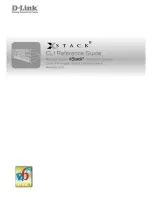
xStack DGS-3400 Series Layer 2 Gigabit Ethernet Managed Switch
NOTE:
If any ports within the trunk group become disconnected, packets intended for
the disconnected port will be load shared among the other linked ports of the link
aggregation group.
NOTE:
Trunking may be done across switches in the switch stack without any
limitations.
Link aggregation allows several ports to be grouped together and to act as a single link. This gives a bandwidth that is a multiple
of a single link's bandwidth.
Link aggregation is most commonly used to link a bandwidth intensive network device or devices, such as a server, to the
backbone of a network.
The Switch allows the creation of up to 32 link aggregation groups, each group consisting of 2 to 8 links (ports). The (optional)
Gigabit ports can only belong to a single link aggregation group. All of the ports in the group must be members of the same
VLAN, and their STP status, static multicast, traffic control; traffic segmentation and 802.1p default priority configurations must
be identical. Port locking, port mirroring and 802.1X must not be enabled on the trunk group. Further, the LACP aggregated links
must all be of the same speed and should be configured as full duplex.
The Master Port of the group is to be configured by the user, and all configuration options, including the VLAN configuration that
can be applied to the Master Port, are applied to the entire link aggregation group.
Load balancing is automatically applied to the ports in the aggregated group, and a link failure within the group causes the
network traffic to be directed to the remaining links in the group.
The Spanning Tree Protocol will treat a link aggregation group as a single link, on the switch level. On the port level, the STP will
use the port parameters of the Master Port in the calculation of port cost and in determining the state of the link aggregation group.
If two redundant link aggregation groups are configured on the Switch, STP will block one entire group; in the same way STP will
block a single port that has a redundant link.
Link Aggregation
To configure port trunking, click on the
Link Aggregation
hyperlink in the
Trunking
folder under
L2 Features
to bring up the
following window:
Figure 7- 15. Link Aggregation Group Entries table
To configure port trunk groups, click the
Add
button to add a new trunk group and use the
Link Aggregation Group
Configuration
window (see example below) to set up trunk groups. To modify a port trunk group, click the Hyperlinked Group
ID. To delete a port trunk group, click the corresponding under the Delete heading in the Link Aggregation Group Entries
table.
124
Summary of Contents for xStack DGS-3426P
Page 310: ...D Link D Link D Link D Link 495 744 00 99 http www dlink ru e mail support dlink ru...
Page 316: ...International Offices...
Page 318: ......
















































